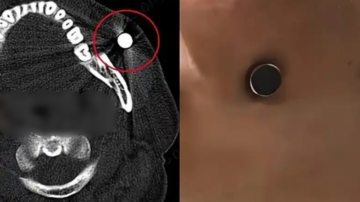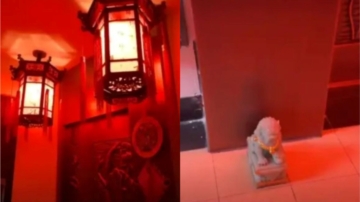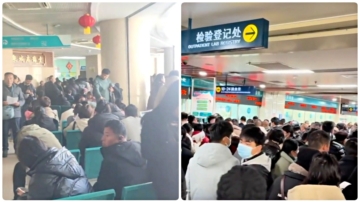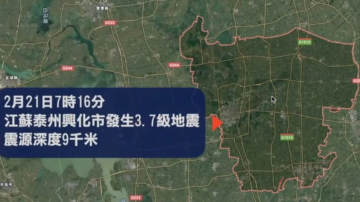【新唐人2014年08月29日訊】中國國家航天局網站上個星期發佈「衛星發現大面積大麻種植區和非法越境通道」的消息,引發國內外轟動。中共公安部在26日通過官媒「闢謠」說,這個消息不是真的。隨後,國家航天局網站刪除了此前發佈的信息。中國大陸的評論人士認為,航天局說的是真話,而公安部在掩蓋真相。
國家航天局網站本月21日發佈消息說,公安部利用「高分一號」衛星數據,在黑龍江、內蒙古、河北等地發現了多處罌粟種植區﹔在吉林、內蒙古等地發現了49年以來最大面積的大麻種植區﹔在中朝邊界、新疆發現數十條非法越境通道﹔在福建發現海上大型走私油庫等。報導還說,這些成果為有關部門執法提供了重要信息支撐。
信息發佈後,各大新聞網站紛紛進行了轉載,引起廣泛關注。
據官媒《京華時報》25日報導,公安部禁毒局否認與國家航天局有過這方面合作,並表示,沒有通過衛星發現種植大麻的情況。
但是《京華時報》又說,與航天局合作的並不是公安部禁毒局,而是公安部科技信息部門。該項目利用公安部衛星的光譜等高科技手段,可以發現種植毒品的情況。
到8月25號下午,國家航天局網站上已經看不到「衛星發現大麻種植區」的文章。國家航天局新聞處負責人張利文對大陸《澎湃新聞》表示,刪除原因是「信息有出入」,但他拒絕透露更多信息。
那麼,航天局和公安部兩個中共官方機構之間,到底誰在說真話?原《人民日報》記者光遠相信,航天局說的是真話。而公安部在掩蓋黑幕。
原《人民日報》記者光遠:「我覺得還是航天部發佈的比較準確。如果它說底下有大麻種植,那肯定會有大麻種植的。這兩個部門沒有默契好。兩個部門沒有協調好。」
光遠進一步分析,這件事可能是兩個部門內鬥的結果。航天局故意捅破消息,給公安部難堪。而這些大麻,甚至不排除是中共內部祕密種植的,但是用途不被外界了解。
光遠:「他們之間沒協調好。甚麼原因,咱們不清楚。一般的是,體制內都是應該互相補臺的,不是互相來拆臺。你非法種植這些大麻,都是一個體制內的,它得給他護短。明顯的不護短,那肯定這裡面有矛盾。」
山東作家鞏磊也相信,航天局說的是事實。而公安部不願意將「祕密」告知天下,才不惜打航天局一耳光。
山東作家鞏磊:「因為這牽扯到公安部的形象,一些政績問題,它當然是極力否認,極力作為保密的一些東西,不願意公諸於眾。因為打擊毒品氾濫是公安的一個職責,它這個職責履行不好,它要負責任,所以他極力否認。」
光遠認為,衛星拍到這麼大批的大麻,如果公安部門不知道,那是嚴重的失職。但他也指出,這麼大面積的種植大麻,如果沒有相當大的保護傘,是做不到的。
光遠還表示,幾年前,他在內蒙古旅遊時,就曾經看到一片人工種植的罌粟。
光遠:「赤峰有一個達賴湖,這達賴湖附近就有人種植這個罌粟。開花非常好看,非常漂亮的小葫蘆,單獨的一個小圓葫蘆,開得五顏六色的花,黃色的,粉色的,非常漂亮。當時我在旁邊照相呢。人家告訴我這就是罌粟。但是我就不知道誰種的。那面積也得有一畝。」
根據公開資料,內蒙古、吉林兩地近年一直有打擊大麻種植的消息傳出。《澎湃新聞》的報導,還引述了一則內蒙古禁毒支隊官網「內蒙古禁毒網」,在2014年5月5號發佈的信息稱,「興安盟積極組織開展罌粟、大麻毒品植原植物禁種宣傳和籽種收繳戰役」,文章中稱,「國家禁毒辦定於6-8月份對我盟進行衛星遙感監測」,鼓勵居民檢舉揭發毒品種植。但在8月28號,「內蒙古禁毒網」已經無法打開。
採訪編輯/秦雪 後製/李勇
China’s Public Security Ministry Denies Space Agency Discovery
China National Space Administration (CNSA), surprised both
home and abroad, for locating large fields of cannabis and
uncovering routes used by smugglers at the border
with North Korea last week.
But, Ministry of Public Security denied such findings
on the Aug. 26.
The CNSA announcement online was also soon deleted.
Mainland commentators believe the Public Security is trying
to cover up the truth which the CNSA accidentally revealed.
CNSA released on Aug. 21t, ministry used data from
Gaofen 1 satellite to locate plantations of opium poppies in
Heilongjiang, Inner Mongolia and Hebei;
the largest illegal marijuana plantation in Jilin
and Inner Mongolia since 1949.
About 10 secret passageways used by people to illegally cross
China’s border in the Xinjiang Autonomous region,
also the border with North Korea;
and a large offshore oil smuggling warehouse in Fujian.
Images taken by the hi-tech satellite, provided “important
informational support” to relevant departments at the ministry
during their law enforcement duties, the space authority said.
This news release was widely published by media
and caused widespread concern.
State media Jinghua reported on the Aug 25, the anti-narcotics
police denied the cooperation with CNSA and the findings
of a cannabis plantation.
Jinghua reported, instead, it is the Science and Technology
Information Department of the Ministry that
collaborated with CNSA.
The Ministry uses a satellite high-tech spectrum
to locate illegal plantations.
The afternoon of Aug. 25, the release was no longer available
on CNSA’s website.
CNSA news center director Zhang Liwen told The Paper,
the release was removed due to "information discrepancies,"
but declined to give more information.
So, between the two Communist official institutions,
who is telling the truth?
Former People's Daily reporter Guang Yuan believes the
Ministry of Public Security, tries to cover up the shady facts.
GuangYuan: "I think the space agency’s information is more
accurate. There is surely cannabis cultivation if it
is said to be so.
But, these two agencies failed to reach a mutual
understanding beforehand."
Guang Yuan further analyzes, it may be the result of infighting
within the two departments.
CNSA deliberately exposed the news to embarrass the Ministry
of Public Security.
He suspects the marijuana was planted by the regime
for unknown usage.
Guang Yuan: "They failed to coordinate on this matter
for reasons we don’t know yet.
In general, all units within the system should supplement,
but are opposing each other.
The illegal plantation of cannabis is within the system.
Rather than help to cover it up, the conflict is obvious."
Shandong writer Gong Lei also believes what CNSA has revealed.
The Ministry of Public Security just slaps CNSA in the face
for reluctance to reveal the "secret".
Gong Lei: "It matters the image and the performance of the
Ministry of Public Security.
It will strongly deny the secrets that were exposed. It is the
public security’s duty to fight the drug. It clearly showed
it’s failed its mission. That’s why it’s denying it."
Guang Yuan indicates, it is a serious dereliction of duty
for the security, failing to find the biggest marijuana plantation.
He also explains, such a large plantation is surely hidden
beneath a large protective umbrella.
Guang Yuan mentions that in a tour of Inner Mongolia a few
years ago, he saw a large field of opium poppies.
Guang Yuan: "There is a Dalai Lake in Chifeng. There were
poppy flowers planted near the lake. The flowers are very pretty.
It comes with little individual gourd. The flowers are in various
colors, yellow and pink, all are very pretty.
While I was taking pictures, people told me they are of the
opium poppy strain. But I do not know who planted them.
The area covers at least one acre."
Reportedly, crackdown on illegal cannabis cultivation has been
heard in Inner Mongolia and Jilin.
The Paper reported a news release by Inner Mongolia drugs
control on May 5 regarding the battle to fight against
illegal plantation of opium poppy and marijuana.
The article described the national drug control will conduct
satellite remote sensing from June through to August and
people were encouraged to report any illegal cultivation.
But, Inner Mongolia drug control Website is not available
on Aug. 28.
Interview & Edit/Qin Xue Post-Production/Li Yong
國家航天局網站本月21日發佈消息說,公安部利用「高分一號」衛星數據,在黑龍江、內蒙古、河北等地發現了多處罌粟種植區﹔在吉林、內蒙古等地發現了49年以來最大面積的大麻種植區﹔在中朝邊界、新疆發現數十條非法越境通道﹔在福建發現海上大型走私油庫等。報導還說,這些成果為有關部門執法提供了重要信息支撐。
信息發佈後,各大新聞網站紛紛進行了轉載,引起廣泛關注。
據官媒《京華時報》25日報導,公安部禁毒局否認與國家航天局有過這方面合作,並表示,沒有通過衛星發現種植大麻的情況。
但是《京華時報》又說,與航天局合作的並不是公安部禁毒局,而是公安部科技信息部門。該項目利用公安部衛星的光譜等高科技手段,可以發現種植毒品的情況。
到8月25號下午,國家航天局網站上已經看不到「衛星發現大麻種植區」的文章。國家航天局新聞處負責人張利文對大陸《澎湃新聞》表示,刪除原因是「信息有出入」,但他拒絕透露更多信息。
那麼,航天局和公安部兩個中共官方機構之間,到底誰在說真話?原《人民日報》記者光遠相信,航天局說的是真話。而公安部在掩蓋黑幕。
原《人民日報》記者光遠:「我覺得還是航天部發佈的比較準確。如果它說底下有大麻種植,那肯定會有大麻種植的。這兩個部門沒有默契好。兩個部門沒有協調好。」
光遠進一步分析,這件事可能是兩個部門內鬥的結果。航天局故意捅破消息,給公安部難堪。而這些大麻,甚至不排除是中共內部祕密種植的,但是用途不被外界了解。
光遠:「他們之間沒協調好。甚麼原因,咱們不清楚。一般的是,體制內都是應該互相補臺的,不是互相來拆臺。你非法種植這些大麻,都是一個體制內的,它得給他護短。明顯的不護短,那肯定這裡面有矛盾。」
山東作家鞏磊也相信,航天局說的是事實。而公安部不願意將「祕密」告知天下,才不惜打航天局一耳光。
山東作家鞏磊:「因為這牽扯到公安部的形象,一些政績問題,它當然是極力否認,極力作為保密的一些東西,不願意公諸於眾。因為打擊毒品氾濫是公安的一個職責,它這個職責履行不好,它要負責任,所以他極力否認。」
光遠認為,衛星拍到這麼大批的大麻,如果公安部門不知道,那是嚴重的失職。但他也指出,這麼大面積的種植大麻,如果沒有相當大的保護傘,是做不到的。
光遠還表示,幾年前,他在內蒙古旅遊時,就曾經看到一片人工種植的罌粟。
光遠:「赤峰有一個達賴湖,這達賴湖附近就有人種植這個罌粟。開花非常好看,非常漂亮的小葫蘆,單獨的一個小圓葫蘆,開得五顏六色的花,黃色的,粉色的,非常漂亮。當時我在旁邊照相呢。人家告訴我這就是罌粟。但是我就不知道誰種的。那面積也得有一畝。」
根據公開資料,內蒙古、吉林兩地近年一直有打擊大麻種植的消息傳出。《澎湃新聞》的報導,還引述了一則內蒙古禁毒支隊官網「內蒙古禁毒網」,在2014年5月5號發佈的信息稱,「興安盟積極組織開展罌粟、大麻毒品植原植物禁種宣傳和籽種收繳戰役」,文章中稱,「國家禁毒辦定於6-8月份對我盟進行衛星遙感監測」,鼓勵居民檢舉揭發毒品種植。但在8月28號,「內蒙古禁毒網」已經無法打開。
採訪編輯/秦雪 後製/李勇
China’s Public Security Ministry Denies Space Agency Discovery
China National Space Administration (CNSA), surprised both
home and abroad, for locating large fields of cannabis and
uncovering routes used by smugglers at the border
with North Korea last week.
But, Ministry of Public Security denied such findings
on the Aug. 26.
The CNSA announcement online was also soon deleted.
Mainland commentators believe the Public Security is trying
to cover up the truth which the CNSA accidentally revealed.
CNSA released on Aug. 21t, ministry used data from
Gaofen 1 satellite to locate plantations of opium poppies in
Heilongjiang, Inner Mongolia and Hebei;
the largest illegal marijuana plantation in Jilin
and Inner Mongolia since 1949.
About 10 secret passageways used by people to illegally cross
China’s border in the Xinjiang Autonomous region,
also the border with North Korea;
and a large offshore oil smuggling warehouse in Fujian.
Images taken by the hi-tech satellite, provided “important
informational support” to relevant departments at the ministry
during their law enforcement duties, the space authority said.
This news release was widely published by media
and caused widespread concern.
State media Jinghua reported on the Aug 25, the anti-narcotics
police denied the cooperation with CNSA and the findings
of a cannabis plantation.
Jinghua reported, instead, it is the Science and Technology
Information Department of the Ministry that
collaborated with CNSA.
The Ministry uses a satellite high-tech spectrum
to locate illegal plantations.
The afternoon of Aug. 25, the release was no longer available
on CNSA’s website.
CNSA news center director Zhang Liwen told The Paper,
the release was removed due to "information discrepancies,"
but declined to give more information.
So, between the two Communist official institutions,
who is telling the truth?
Former People's Daily reporter Guang Yuan believes the
Ministry of Public Security, tries to cover up the shady facts.
GuangYuan: "I think the space agency’s information is more
accurate. There is surely cannabis cultivation if it
is said to be so.
But, these two agencies failed to reach a mutual
understanding beforehand."
Guang Yuan further analyzes, it may be the result of infighting
within the two departments.
CNSA deliberately exposed the news to embarrass the Ministry
of Public Security.
He suspects the marijuana was planted by the regime
for unknown usage.
Guang Yuan: "They failed to coordinate on this matter
for reasons we don’t know yet.
In general, all units within the system should supplement,
but are opposing each other.
The illegal plantation of cannabis is within the system.
Rather than help to cover it up, the conflict is obvious."
Shandong writer Gong Lei also believes what CNSA has revealed.
The Ministry of Public Security just slaps CNSA in the face
for reluctance to reveal the "secret".
Gong Lei: "It matters the image and the performance of the
Ministry of Public Security.
It will strongly deny the secrets that were exposed. It is the
public security’s duty to fight the drug. It clearly showed
it’s failed its mission. That’s why it’s denying it."
Guang Yuan indicates, it is a serious dereliction of duty
for the security, failing to find the biggest marijuana plantation.
He also explains, such a large plantation is surely hidden
beneath a large protective umbrella.
Guang Yuan mentions that in a tour of Inner Mongolia a few
years ago, he saw a large field of opium poppies.
Guang Yuan: "There is a Dalai Lake in Chifeng. There were
poppy flowers planted near the lake. The flowers are very pretty.
It comes with little individual gourd. The flowers are in various
colors, yellow and pink, all are very pretty.
While I was taking pictures, people told me they are of the
opium poppy strain. But I do not know who planted them.
The area covers at least one acre."
Reportedly, crackdown on illegal cannabis cultivation has been
heard in Inner Mongolia and Jilin.
The Paper reported a news release by Inner Mongolia drugs
control on May 5 regarding the battle to fight against
illegal plantation of opium poppy and marijuana.
The article described the national drug control will conduct
satellite remote sensing from June through to August and
people were encouraged to report any illegal cultivation.
But, Inner Mongolia drug control Website is not available
on Aug. 28.
Interview & Edit/Qin Xue Post-Production/Li Yong








